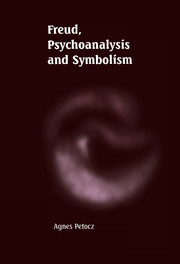Book contents
- Frontmatter
- Contents
- List of figures
- Preface
- Introduction
- Part One Exegesis and Extraction
- 1 From disorder towards the focus of inquiry
- 2 The ‘Freudian Narrow’ (FN) theory of symbolism
- 3 The ‘symbol’ in Freud's early writings (1893–1899)
- 4 Continuation and elaboration (1900–1913)
- 5 The ‘core years’ for the FN theory (1914–1917)
- 6 The treatment of symbolism in Freud's later writings (1918–1940)
- Part Two Consolidation and Defence
- Epilogue
- List of references
- Index
3 - The ‘symbol’ in Freud's early writings (1893–1899)
Published online by Cambridge University Press: 22 October 2009
- Frontmatter
- Contents
- List of figures
- Preface
- Introduction
- Part One Exegesis and Extraction
- 1 From disorder towards the focus of inquiry
- 2 The ‘Freudian Narrow’ (FN) theory of symbolism
- 3 The ‘symbol’ in Freud's early writings (1893–1899)
- 4 Continuation and elaboration (1900–1913)
- 5 The ‘core years’ for the FN theory (1914–1917)
- 6 The treatment of symbolism in Freud's later writings (1918–1940)
- Part Two Consolidation and Defence
- Epilogue
- List of references
- Index
Summary
In Freud's early writings, there are two distinct usages of the term ‘symbol’. The first plays a central part in Freud's account of conversion symptoms in hysteria, and the second is a wider application of the term, usually in the context of defence, but according to which symbol formation may be either pathological or normal.
Symbolism in hysteria
The first usage may be subdivided into (i) the concept of a ‘mnemic symbol’ in hysteria, and (ii) the process of ‘symbolization’ (spelled with a ‘z’ here to distinguish it as a technical term) in hysteria. The distinction between these two is that ‘symbolization’, unlike the ‘mnemic symbol’, is dependent on linguistic (particularly metaphorical) expressions, and is, in a sense, secondary to (and dependent on) the original formation of a mnemic symbol.
The concept of a ‘mnemic symbol’ first occurs in the Freud and Breuer ‘Preliminary communication’ (1893), in the Studies on Hysteria (1895a). The authors argue that, in hysteria, the affect which accompanies a traumatic experience, instead of being ‘discharged’, remains in a ‘strangulated’ state, and the memory of the experience to which it is attached is cut off from consciousness. Instead of there being an affectively-charged memory, then, the dissociated affect becomes ‘converted’ into a hysterical symptom, and this hysterical symptom may be regarded as a ‘mnemic symbol’, since it has replaced (‘stands for’) the repressed memory.
- Type
- Chapter
- Information
- Freud, Psychoanalysis and Symbolism , pp. 36 - 55Publisher: Cambridge University PressPrint publication year: 1999



